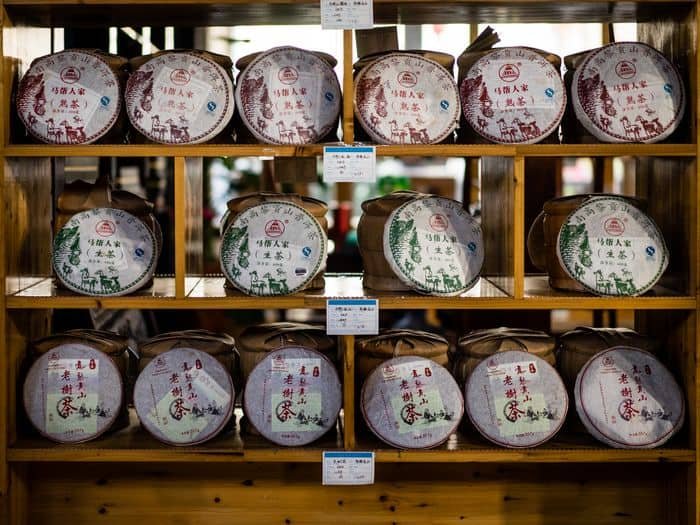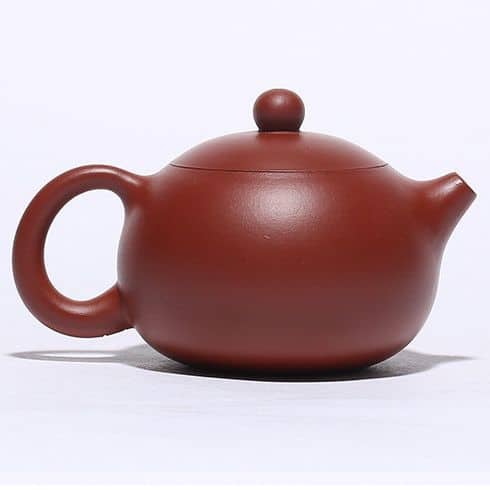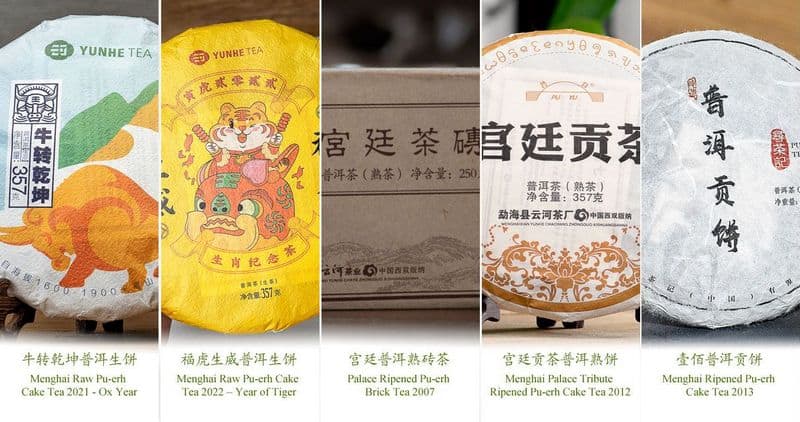
Pu-erh tea (also written pu’er) is a dark tea generally produced in Yunnan, China. It is referred to post-fermented tea in the west and as black tea in Asia. This can create some confusion with what we generally call black tea (and people in Asia refer to as red tea).
Pu’er tea is sold in loose leaf form and in bricks. It is typically aged before consumption and is labeled with the region and year of origin.
It is also labeled with one of over ten grades, but these are not exactly consistent between producers. Different grades differ in flavor and many bricks will actually blend several grades to achieve a balance of flavors.
Table of Contents
Where To Buy Pu’Er Tea
As pu’er tea is gaining in popularity in the west, it can be found in most specialty tea shops or through a number of online vendors. If you are unsure where to begin, you can check out some of my recommendations below.
How To Brew Pu-erh Tea
While there are variations in the brewing methods for individual varieties, pu’er tea is traditionally brewed using the gongfu method. This method calls for a larger amount of leaves to be steeped very briefly. As a result of the short steeping times, pu’er leaves are generally good for ten or more infusions.
If you’ve ever had a very bitter cup of pu-erh, it was likely brewed in the western style, meaning it was oversteeped.
Brewing pu’er in the gonfgu style is best done using an yixing:
These traditional Chinese teapots are made from purple clay and come in a large variety of shapes and sizes.
A traditional gaiwan works as well and is cheaper and takes up less space.
The nice thing about both the yixing and the gaiwan is that they can also be used to brew most Chinese teas, be they oolong, green, white or black.
Brewing Instructions
- If using an yixing, pour hot water over it to pre-heat it. If using a gaiwan, fill it about halfway with hot water and tilt it a bit so that the water creeps up the side and then rotate it so the inside gets wet all the way around. Then pour the water out. Do the same for any tea cups.
- The amount of tea to use depends very much on personal tastes. As a good starting point, put around 2 teaspoons of tea leaves in your gaiwan or yixing (assuming it holds 4 oz or 114 ml of water).
- Pour enough hot water into the vessel to just cover the leaves.
- Discard the water after 2 seconds. This will rinse the leaves. If you are using a ripe pu’er (see below for info), repeat this process one more time.
- Fill the gaiwan or yixing with hot water. The temperature should be around 95ºC (203ºF) for regular varieties and 85-90ºC (185-194ºF) for high-quality aged varieties.
- Place the lid on the vessel and let the tea steep for 20-30 seconds. Then pour the tea into the cup(s) for drinking.
- For each subsequent infusion, add 5-10 seconds to the steeping time. You can generally get more than 10 infusions out of pu-erh leaves. The higher quality the tea, the more infusions it will give you.
Use the amounts given in these instructions as a rough guide. If you find the resulting tea too weak, add more tea leaves; if it is too strong, reduce the amount of leaves used. Similarly, try increasing or decreasing the steeping times. Basically, you’ll want to keep experimenting until you come up with the perfect brew for your particular taste.
Pu-erh Tea Varieties
There are two main types of pu’er tea: Sheng Cha (raw tea) and Shou Cha (ripe tea). Both begin as Mao Cha (rough tea), a very lightly oxidized “large-leaf” green tea.
This Mao Cha can be sold directly as loose leaf pu-erh, it can be compressed immediately to produce Sheng Cha or it can be aged first, then compressed into Sheng Cha.
It can also be turned into “ripe tea” (Shou Cha), using a relatively new process that approximates the result of the traditional aging process.
Some traditionalists dispute the legitimacy of this new (developed in the 1970s) procedure. However you feel about that, it produces teas that are quite different from the traditional Sheng Cha variety, but also much cheaper.
Best Pu’Er Teas
Most Convenient
The most convenient place to buy tea for most people is Amazon.com. You won’t generally find the highest qualitiey varieties here, but they have a few good options when it comes to ripe pu’er (Shou Cha). This 2010 Longrun Pu-erh Tea from Dali in Yunnan is a good buy, as is this loose leaf compressed variety that comes in a bamboo leaf tube.
I have not found a good Sheng Cha (raw tea) on Amazon.
Highest Quality
Generation Tea specializes in the highest quality Chinese teas and they have an exceptionally large selection of Pu-erh. Their website has finally been updated, so that solves their biggest problem (though it is still far from modern).
Their selection ranges from teas that cost $10 to one from the 1930s that costs $30,000 (yes, you read that correctly). Check out their selection for yourself.
With so many options, it can be hard to pick one. The descriptions generally give you a good idea what to expect from each tea and should help you make a decision.
The older the tea, the more it will cost, so you can save a lot of money by buying a younger tea and letting it age yourself. You could also make a lot of money by reselling it once it has aged. Quite a few people buy pu-erh teas as an investment.
If you want some recommendations, this loose leaf raw (Sheng) pu’er from the 1980s is excellent and quite affordable.
If you’re looking for a good pressed tea you can either drink now or let age for a few years and that doesn’t cost too much, this 2004 Grand Red Label Raw Beeng Cha is a great choice. It is young, so it will taste bitter if you drink it now, but using very short steeps will reduce the astringency. Or you could let it age first.
If you want a tea that should make a great investment, try the popular Green Beeng Cha from 2002. A cake sells for $350, while a cake from 1995 sells for $3400.
Best Value
Perhaps the best value purchase you’ll find online is this Pu-erh sampler from Teavivre.
It features small samples of 5 great pu’er cakes for $20 (and it’s often on sale for even less). This is a great way to try several types, both ripened (Shou Cha) and raw (Sheng Cha) and find out which best suits your tastes.
Teavivre has a pretty large selection of Pu’er teas overall. If you are looking for a loose leaf variety, this Yunnan Palace ripened loose pu-erh is a good option. For a ripened cake, try this wonderful 2013 Fenqing Golden Buds Cake or these cute little ripened aged mini Tuocha bricks.
If you prefer a raw pu’er, you can’t go wrong with this 2017 Xia Ke Ji Raw Pu’er Cake. Of course, there is also the smaller raw mini Tuocha option.


Dear Tea Friend,
Good day!
I’m Roger from Sun Time Tea Company, I’m very glad to contact you!
Our tea garden is located in Anhui, and our office is located in Wuhan, Hubei. We have developed all types of fine Chinese teas and tea accessories through many years. Welcome to visit!
Our tea garden is almost wild, the tea bushes are surrounded by diverse plants, and we never use pesticides!
We export a lot to North America and Europe. We have got many EU Standard and Organic clean teas.
We have both gourmet speciality teas and good price bulk teas, welcome to enquire!
Hi, my name is Greg im 45 been farming most of my life so i got to stay some what healthy to show these young punks how to work. Anyways i had some kidney probs, quit coffee and started drinking tea and Wow never new what i was missing, love it best thing i ever done.
I feel the same. I was never a big coffee drinker, but I did sometimes drink soda. I feel much better drinking tea instead.
Thanks for the info–I purchased the sampler for $20.40 including shipping to the mid-west and am looking forward to it. I have purchased pu-erh tea from Yunnan Sourcing once before and liked what I got, but shipping is expensive.
I hope you enjoy it! It’s a good way to find your favorite type of pu-erh.
Tea lovers can find scads of peurh teas at New Century Gallery in Seattle through Grace Li and her Chinese family- a great experience when you go there. She only sells a limited variety online and hundreds of options there – insists you taste each tea before you buy it!
Thanks for this information. I’ve ordered a couple of the teas you recommend here and found the one I’ve tried to be quite delicious. A question — how best to store and age sheng pu-erh tea? The tea cake came in a sturdy foil-lined zip-lok-type bag. Should I store as is in a drawer, put the cake in a zip-lok with a drying agent like silica gel or should I remove the tea from the foil pouch it came in and just leave the wrapped tea cake in a kitchen drawer.
Thank you.
It needs some airflow to age it, so you’ll want to take it out of the sealed packaging. I’m far from an expert on pu’er, but what I’ve been told is that the best place to store it is actually in an Yixing container (i.e. the same clay material as Chinese teapots), because they breathe. But you can also put it in a glass or metal container. Just let some air in occasionally. They important thing is to store it somewhere with a steady temperature and humidity.
Thanks, Daniel. One more thing: Is there such a thing as “organic” pu’ er tea. I’m curious if herbicides are used on tea trees and bushes.
I’m sure there is, but pu’er tea comes from China. You can’t trust any labels they might put on something. I would assume all teas grown in China are grown using considerable amounts of herbicides.